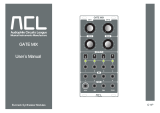
Getting Started
It’s a VCA, It’s a VCF...
The Low Pass Gate operates simultaneously in the amplitude and frequency domains. As the Control
Signal becomes more positive, the Amplitude of the processed signal in-creases with the lower frequencies
being more quickly amplified than high frequencies. As the Control Signal become less positive, the
Amplitude decreases with the high frequencies being attenuated much sooner than the low frequencies. The
net effect is that in fast, transient modulation of the signal’s amplitude the low frequencies will be more
pronounced, lurking in the spectrum, while the high frequencies are eagerly diminished. Manual
manipulation of the controls will not well display this phenomenon. A fast/ short envelope (control signal) of
around +8V will provide beautiful example of the Optomix’s ability to produce acoustic like Attack & Decay
transients. The processed signal will seem to ring, not unlike a struck drum, piano string or xylophone bar.
The DAMP CV will lessen this ringing, not unlike applying your hand to the head of a drum while striking or
muting a guitar string with your palm while plucking; increasing the DAMP parameter could be likened to
applying greater pressure, further muting, until finally, there is almost no ringing.
In the past it has been common practice to follow the Low Pass Gate with a VCA in order to control the
RINGING and reduce or eliminate the signal bleed associated with Low Pass Gates. The DAMP circuit in the
Optomix allows for this control without the use of an additional VCA. To control the ringing adjust the DAMP
CV Attenuator or apply a control signal to the DAMP Control IN. To reduce the signal leakage (when the
Gate is closed), add a touch of DAMPing. If further reduction of signal bleed is needed (during extremely
quiet passages for example) use 2 gates in series. Normalization of Signal OUT CH. 1 to Signal IN CH. 2
makes this possible without additional patching.
Tips and Tricks
The DAMP CV IN may act as an ACCENT parameter if utilizing the Optomix in a sequencing patch. Patch
your non-Accent Envelope signal to the Control IN and set the associated attenuator to about 70%. Apply an
Accent GATE/ signal to the STRIKE IN. Steps where the Accent Gate is Triggered will be LOUDER.
Add to the above patch, some DAMPing on the Accented Steps, by multing that same Accent Gate to the
DAMP CV IN and setting the associated attenuator to taste (at least 20%).
Set up a dynamic FM patch using Optomix to control the FM INDEX. Rather than applying an envelope to
the Control input, just apply a gate to the Strike input and set Damp to taste. Great for burst of modulation,
works with any mod source (LFO, Ran-dom, Noise etc...)
Program a palm mute by applying your gate signal to both STRIKE IN on the Optomix and the TRIGGER IN
on MATHS. Set MATHS for longer Rise time, at least 60% and short Fall time (less then 50%). Apply Signal
OUT MATHS to DAMP CV IN on Optomix, set associated attenuator to at least 65%.














